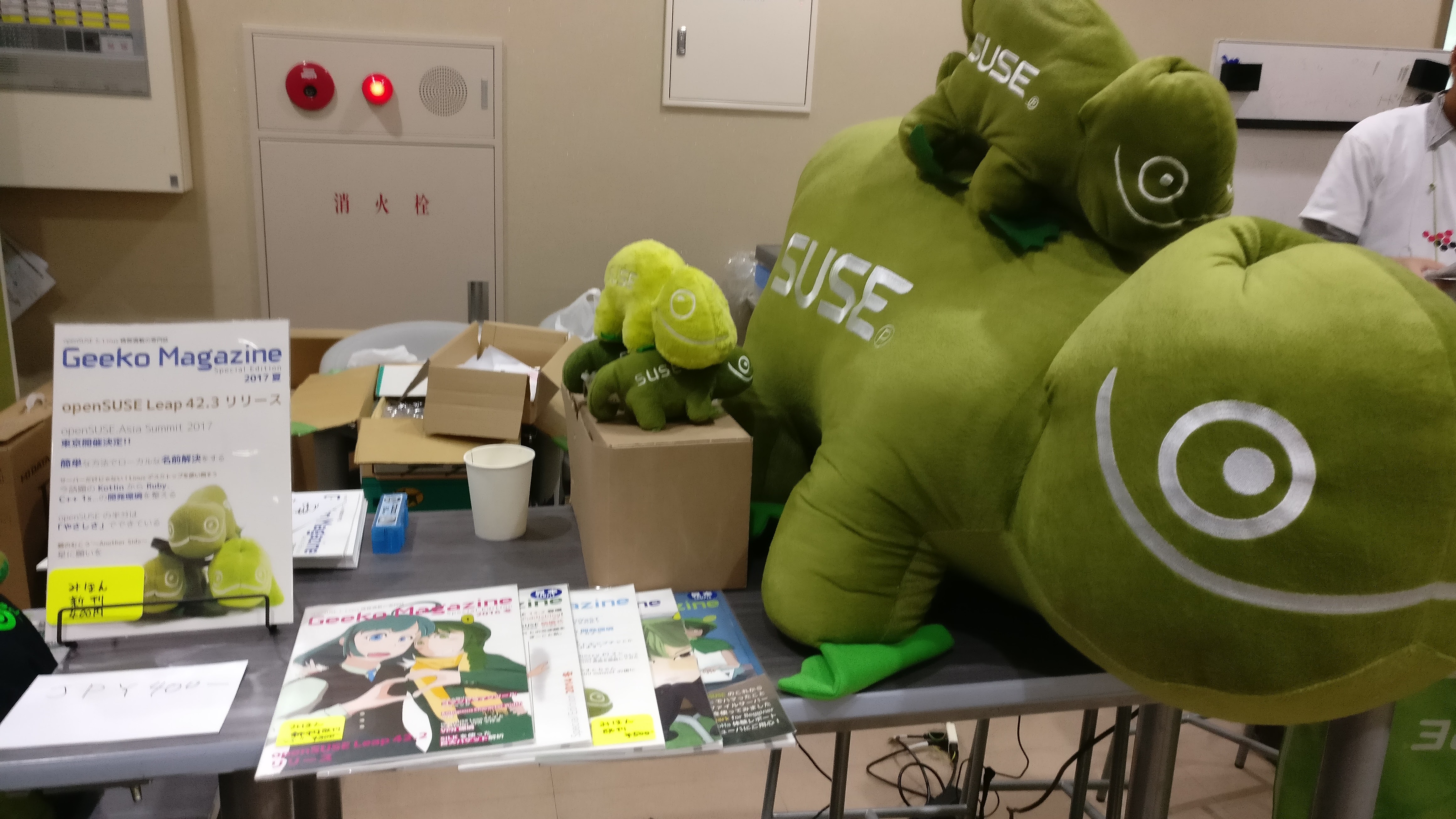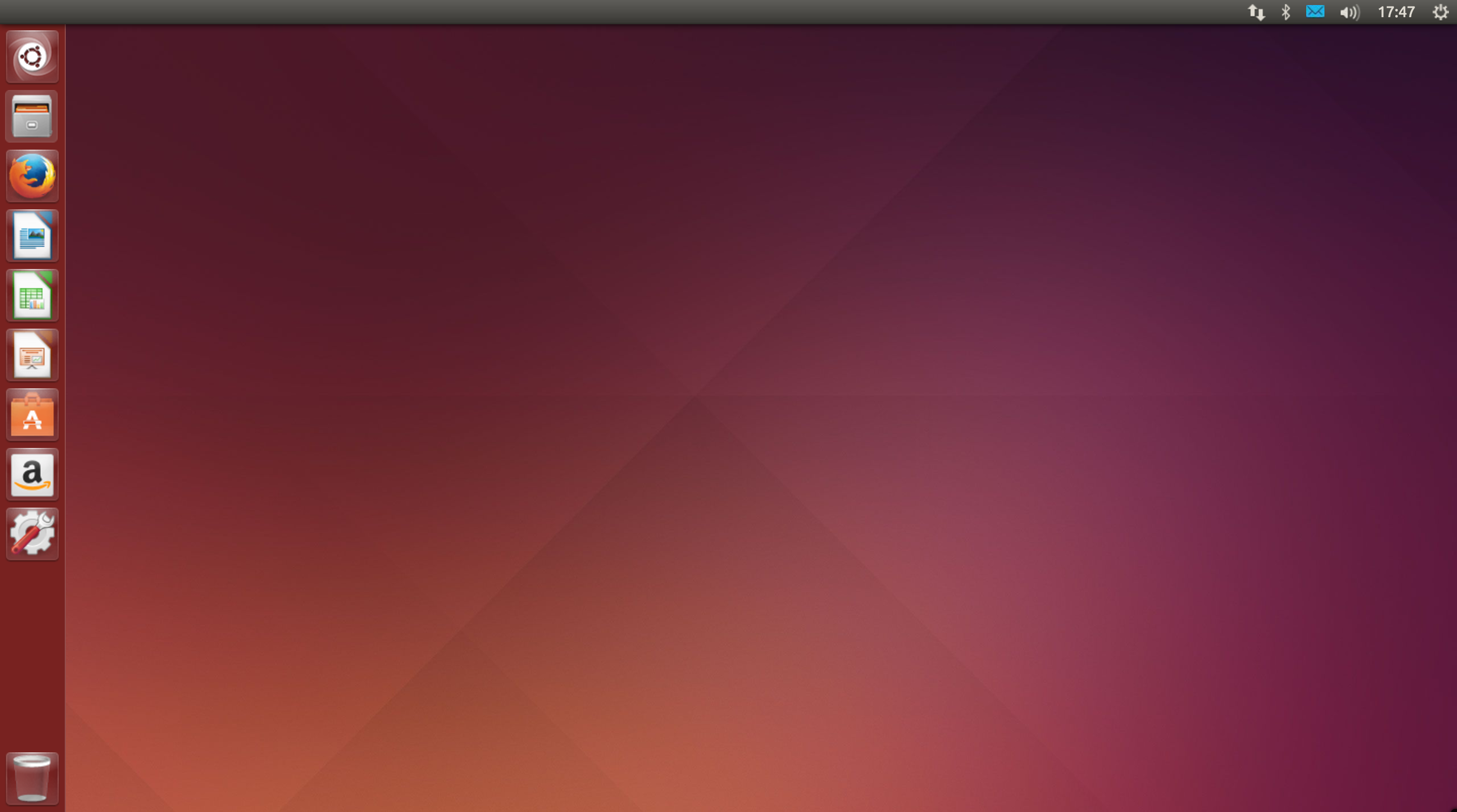Whenever i saw the conference that hold overseas, I wanted to attend. Last summer, I heard that GNOME.Asia will be hold at Chongqing. So i planned to attend. But, because of my school midterm exam, I couldn’t attend GNOME.Asia. Luckily, I got a information from Nogata Jun that openSUSE.Asia will be hold at Tokyo. Since Tokyo is much near from Seoul then Chongqing, and it will be hold after the exam, I decided to attend openSUSE.Asia. I wanted to book a hotel. But, Since hotels near Chofu was expansive for me, I’ve booked a AirBnB instead.
Day 1
After the midterm exam, I departed from Incheon Airport at October 20th. I arrived at about 1’o Clock PM and moved to my AirBnB located near Keio Tamagawa station It was near from the venue, But very far from the Narita Airport. It took about 2~3 hours to get there. So, i used all of the time for moving. Because Shinjuku station was huge and complicated for me, It also took a bit to transfer to Keio Line.
Dinner
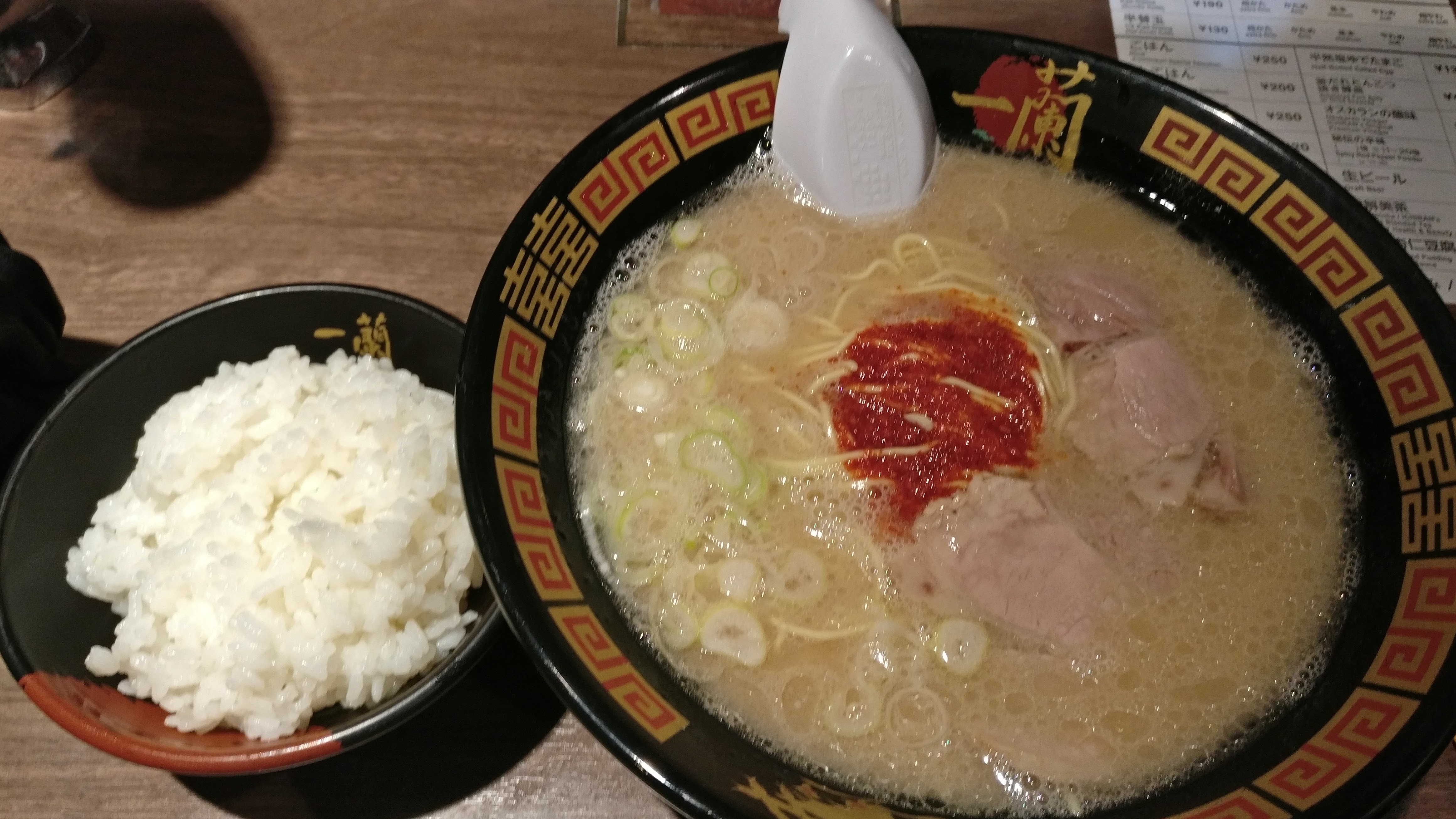 Because i was busy moving to my accommodation, I skipped the lunch.
I had a dinner near Shinjuku station. But not near Chofu or Keio Tamagawa station.
I went to near Chofu station. Because it’s near from my accommodation and my AirBnB host recommended to look around there. I just visited the restaurant where has high scores and many reviews on Google Map.
But, since they provide their service in only Japanese, I couldn’t order any food.
So, I just headed over to near Shinjuku station with some expectation that i could order food easily.
I visited Ichiran ramen restaurant where famous among tourists for its ramen.
Since it’s been very well known restaurant, I had to wait for long time along the long line.
The restaurant had a unique structure that every seat is isolated with partition. Which aims people to focus on the taste of the food.
Because they provide their service with various language(Japanese, English, Chinese, Korean), It was very easy to order my food. And also the ramen was great.
Because i was busy moving to my accommodation, I skipped the lunch.
I had a dinner near Shinjuku station. But not near Chofu or Keio Tamagawa station.
I went to near Chofu station. Because it’s near from my accommodation and my AirBnB host recommended to look around there. I just visited the restaurant where has high scores and many reviews on Google Map.
But, since they provide their service in only Japanese, I couldn’t order any food.
So, I just headed over to near Shinjuku station with some expectation that i could order food easily.
I visited Ichiran ramen restaurant where famous among tourists for its ramen.
Since it’s been very well known restaurant, I had to wait for long time along the long line.
The restaurant had a unique structure that every seat is isolated with partition. Which aims people to focus on the taste of the food.
Because they provide their service with various language(Japanese, English, Chinese, Korean), It was very easy to order my food. And also the ramen was great.
Day 2
Next day, openSUSE.Asia had began. It was hold at The University of Electro-Communication located near Chofu station. I checked in at the reception, then waited until the keynote. There were many booths and attendees around the reception. While waiting for the keynote, I just said hello to other attendees. Since most attendees could speak and understand English, It was comfortable to have conversation with them. I could also hear some interesting stories.
Opening and Keynote
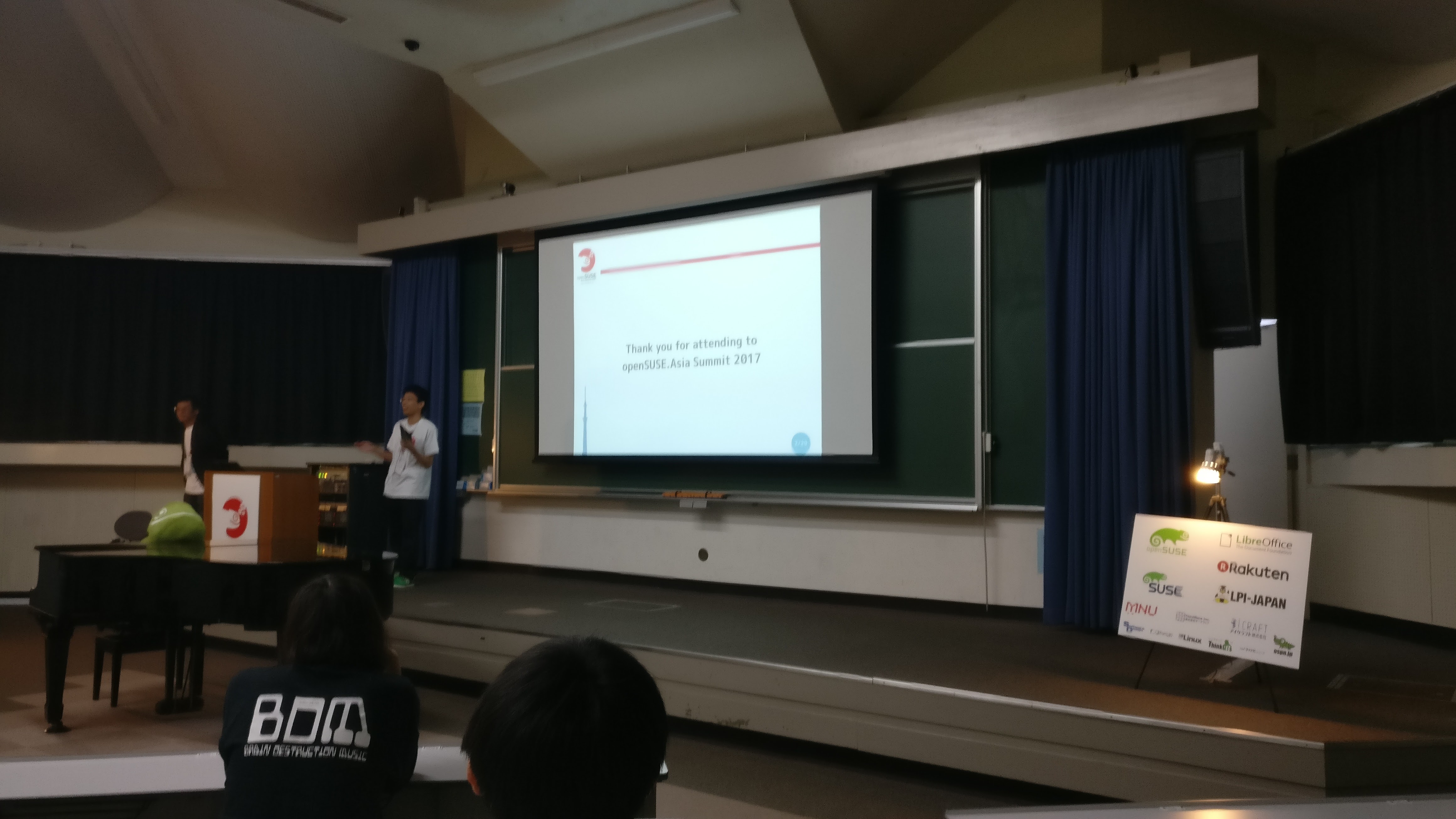
Fuminobu Takeyama, Committee Chair of openSUSE.Asia, introduced about the conference. He announced about the reason and objectives of organizing the event. and also announced about the Summit Party for the day’s evening.
Just after the announcement, Richard Brown, Chair of the openSUSE Board, Re-introduced about openSUSE project. Because some attendees might use other linux distribution or might not know about openSUSE, His presentation that attracts interest from listeners with introduction was great.
First, he introduced what is openSUSE projects, then other projects of openSUSE but not openSUSE distribution project. He talked about openQA which is a test automation system for OS, and OBS(Open Build Service) that can be used for build and distribute not just openSUSE packages but also packages for other distros.
He also talked about the reason why openSUSE was separated into two distros. Tumbleweed and Leap. There were two kinds of people: People who want to adapt new things quickly, and people who want to keep things stable. To satisfy both, Tumbleweed which is a rolling release version of openSUSE, and Leap which is traditional version were released. He compared openSUSE Tumbleweed with other rolling release distros such as Arch and Gentoo.
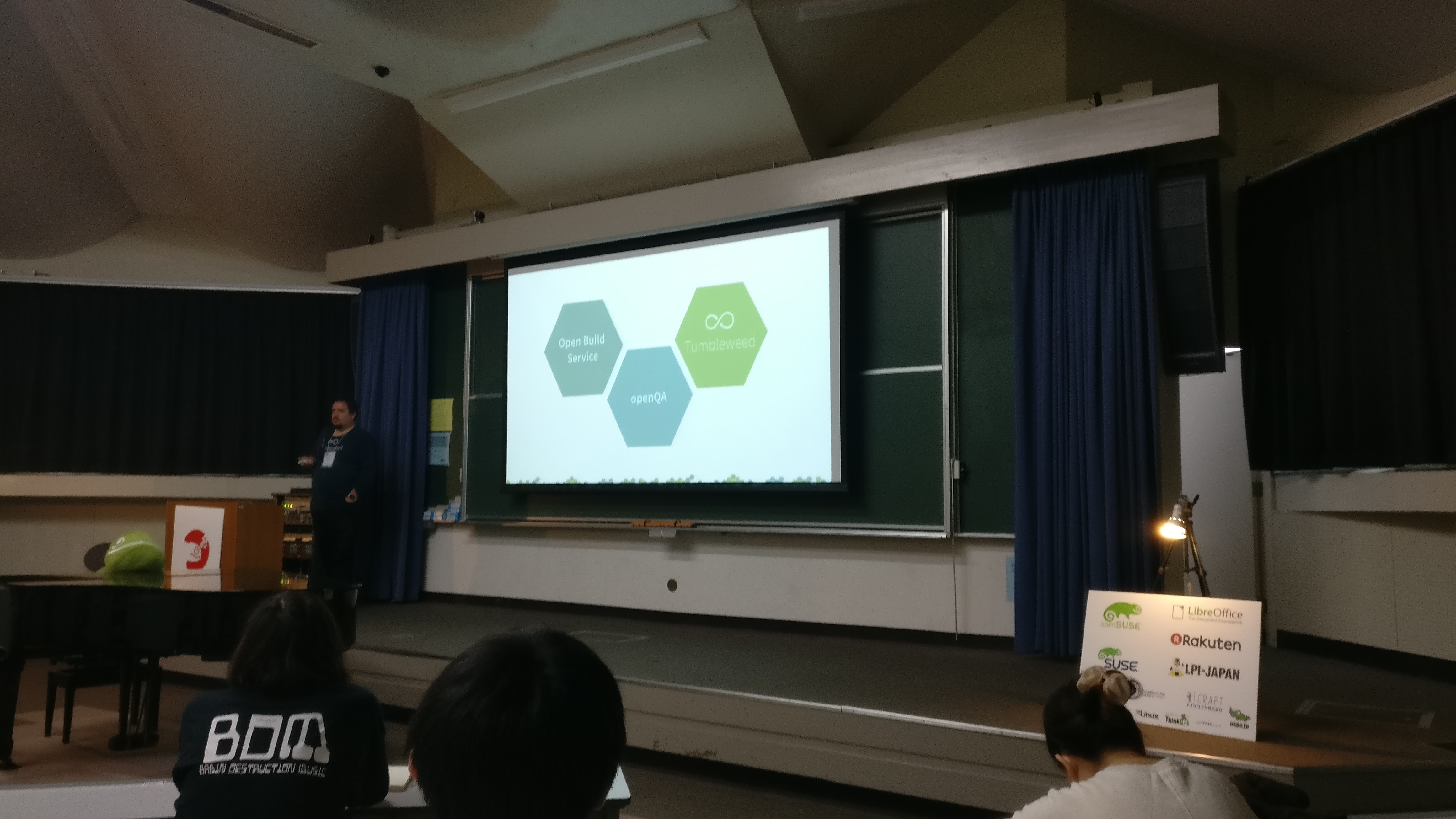
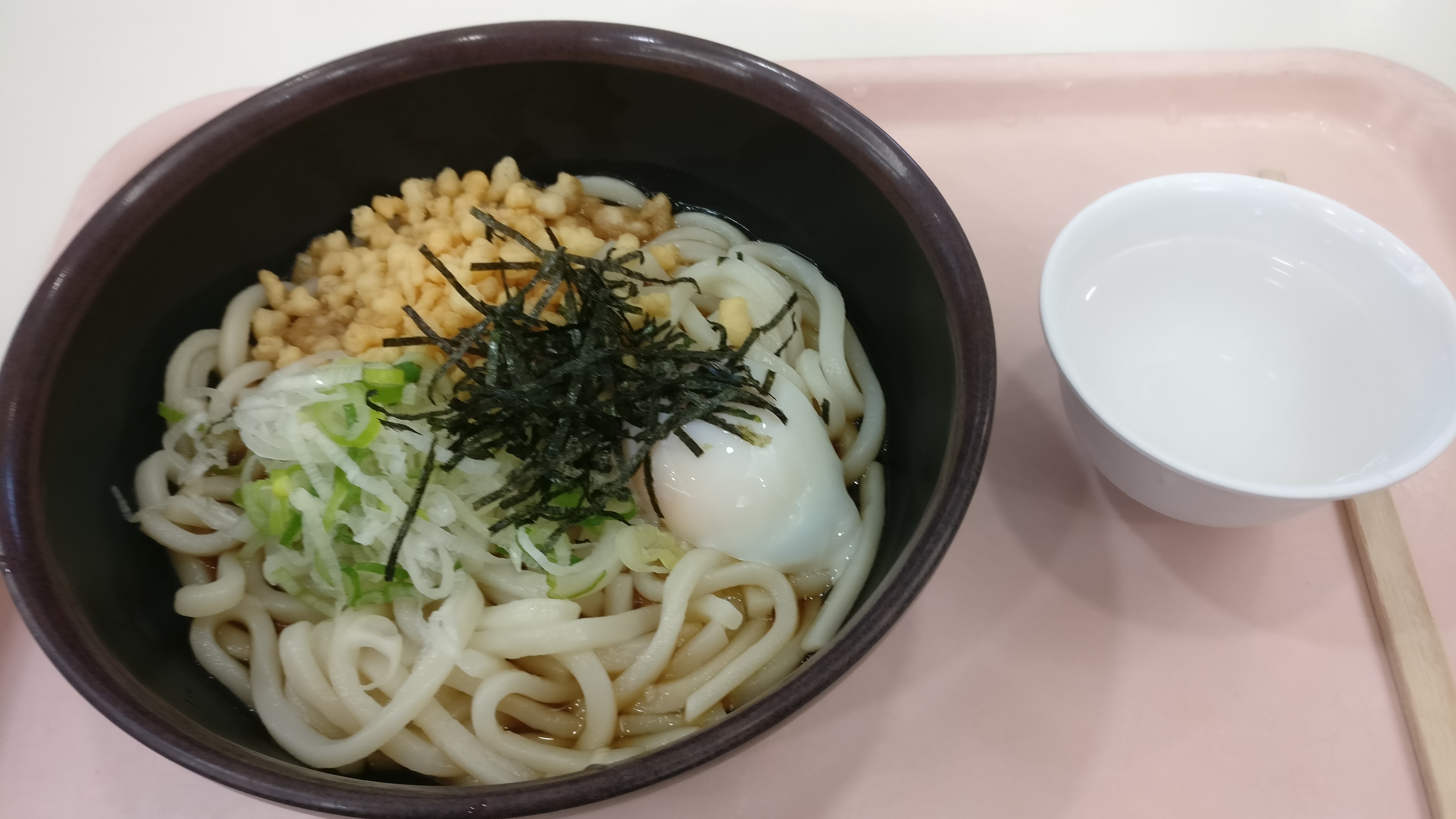
Some memorable presentations
YaST, NFS and Raspberry Pi
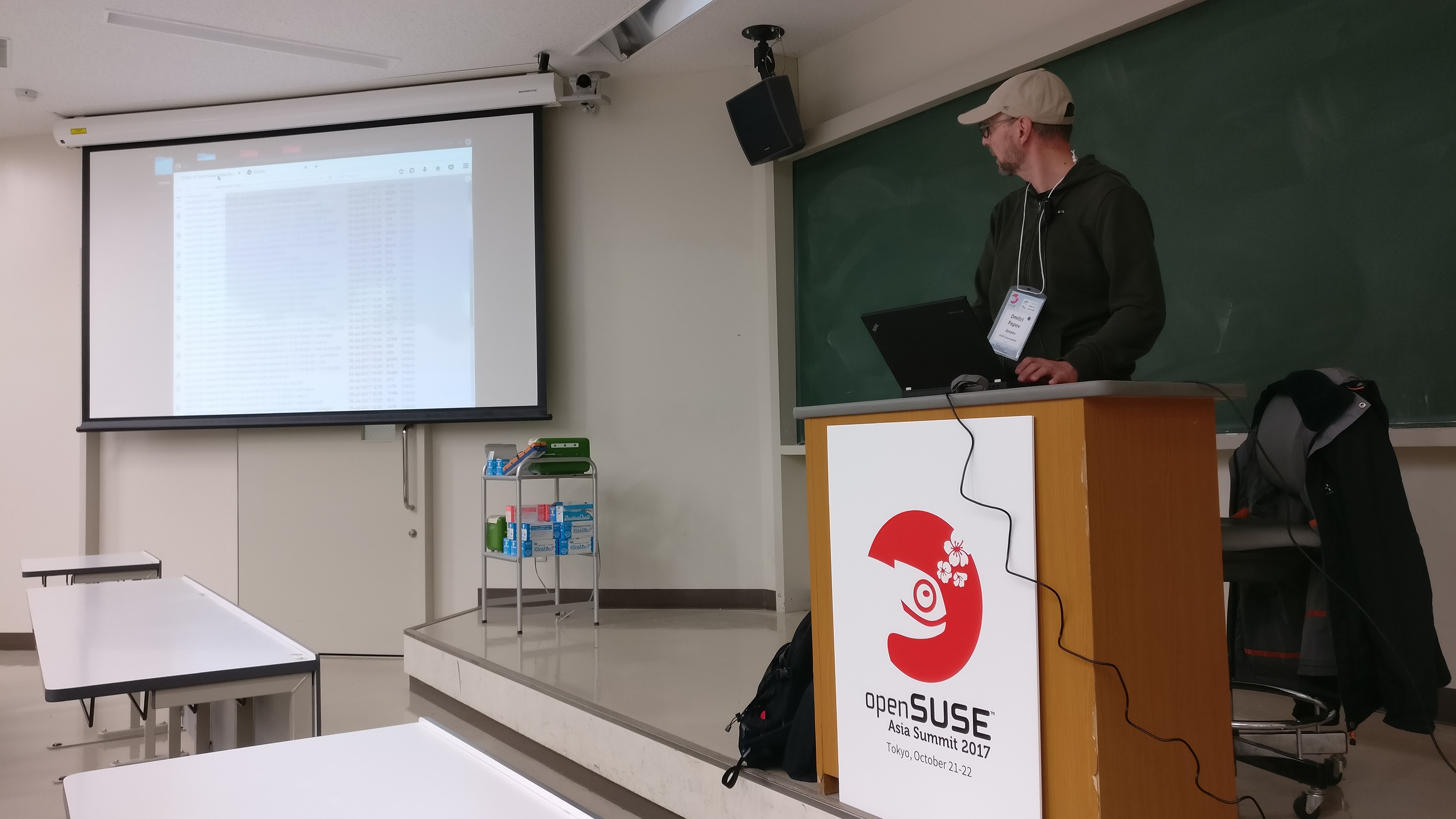
Dmitri Popov talked about how to setup NFS on Raspberry Pi with YaST, system configuration tool for openSUSE. He didn’t brought his Raspberry Pi. Instead, he demonstrated by connecting to his computer remotely. I was impressed that the configuration was done very simply with YaSY by just typing some values or selecting item with. I could know why people use openSUSE because of YaST.
Have Fun Claim Control your Docker Images with Portus on openSUSE Leap
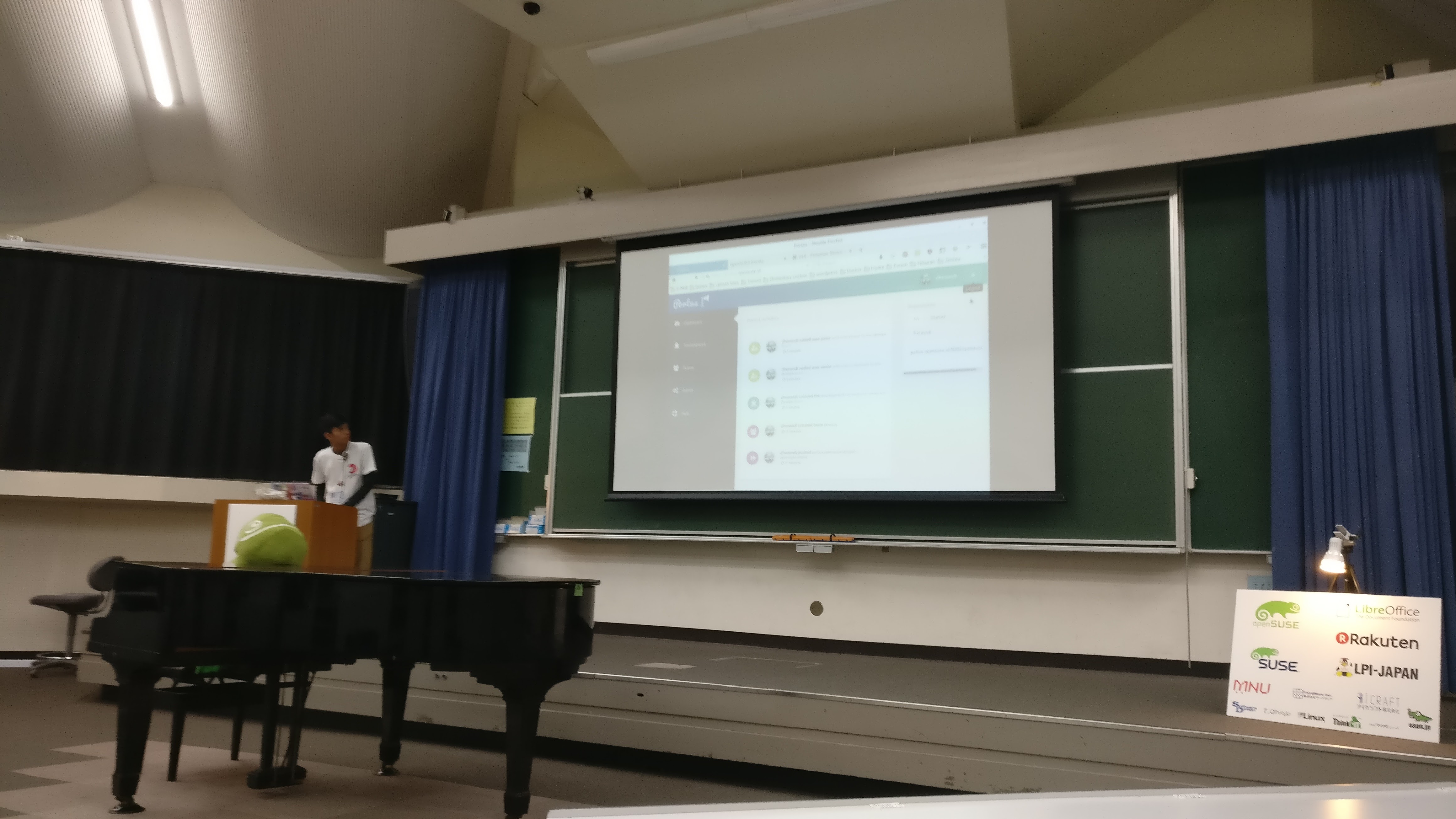
Muhammad Dhenandi Putra introduced about Portus which is a project of openSUSE. He talked that Portus is a project that can be used as a Web interface for managing Private Docker Registry. Also, He demonstrated the usage of Portus.
Flatpak & AppImage Usage on openSUSE. Which One Suitable for openSUSE Users?
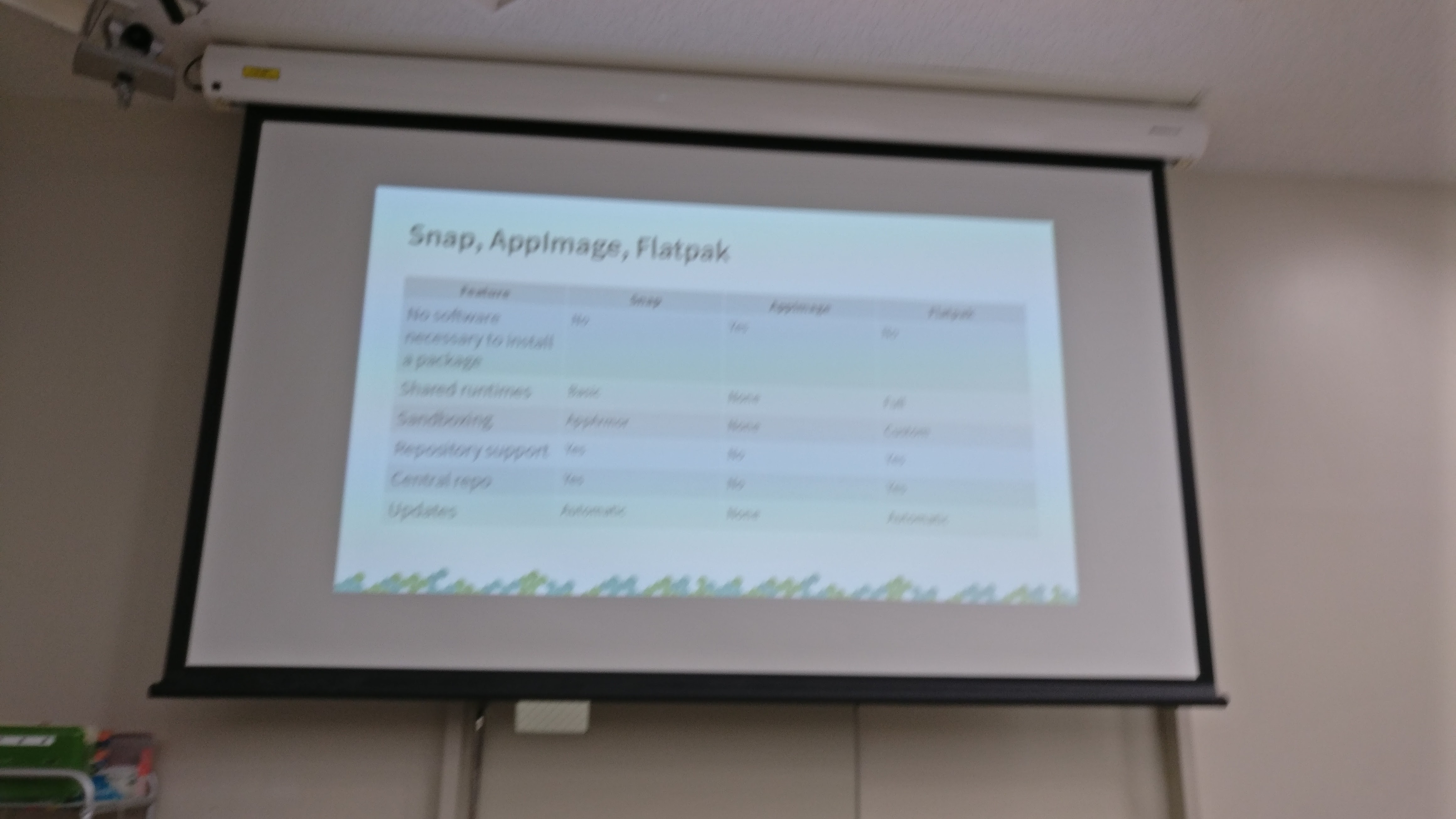
Kukuh Syafaat introduced and compared three different universal linux package format: Snap, Flatpak and AppImage.
First, He briefly introduce about them, then he especially described about AppImage.
I thought they are just quite similar package format before.
But after his speech, I learned that they actually have many differences.
I learned that Snap is suitable for packaging any software, but a bit buggy and not stable non ubuntu distros.
Flatpak is similar as Snap, but it is focused on desktop, and it’s stable on various distros.
AppImage is also similar as Snap and Flatpak. But it was interesting that AppImage is more like *.exe file from Windows and *.dmg file from MacOS.
Lightning Talks
In Lightning Talk, All speeches are done in 5 minutes. This time, I also gave people a speech. I talked about how & why our community(Ubuntu Korea Community) connected Slack & IRC. After my speech, there were many interesting speeches. such as Building Cross VR Experience in 5 minutes, How to become a TDF(The Document Foundation) Member, and a talk about LXD and LXC.
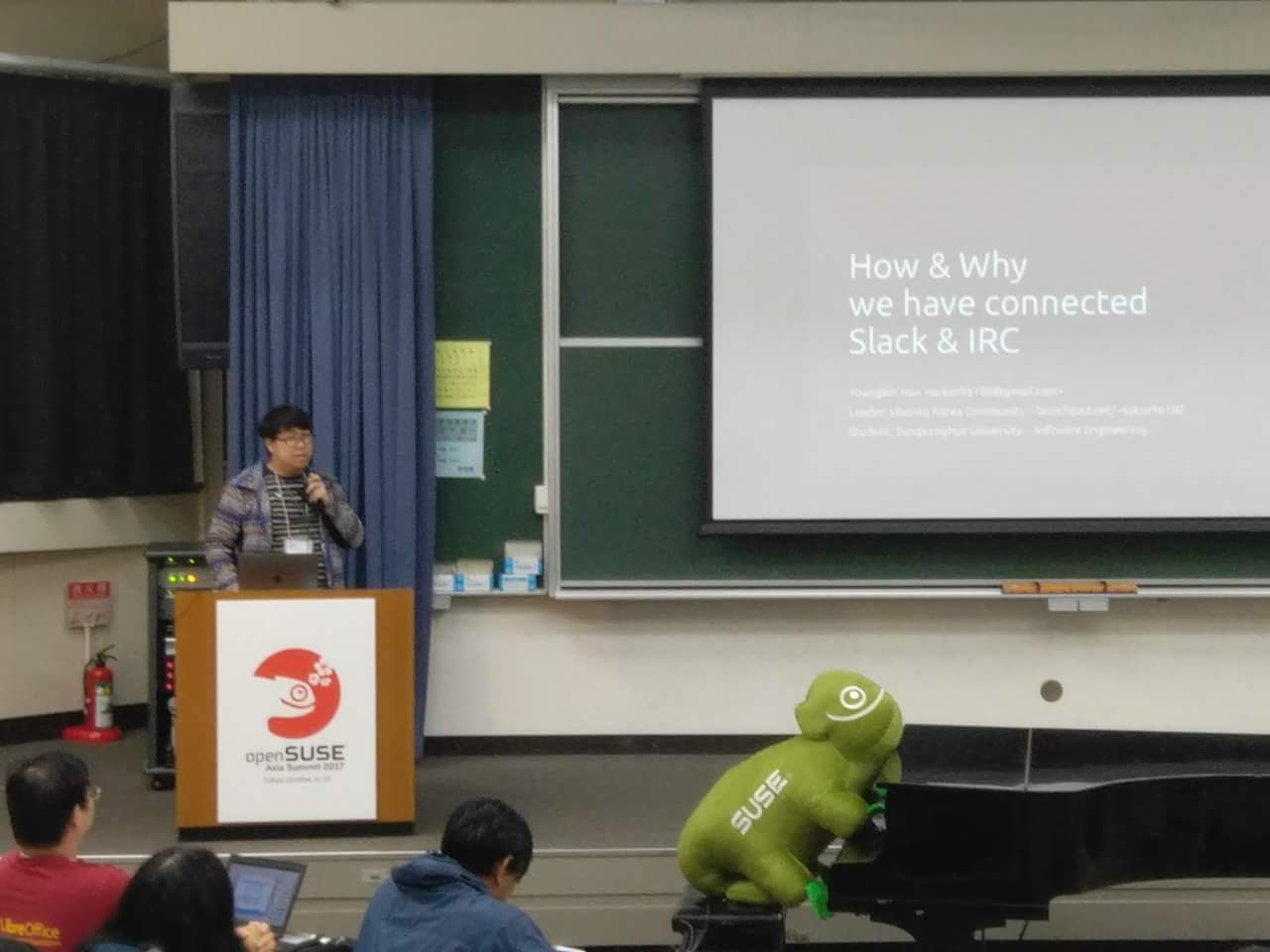
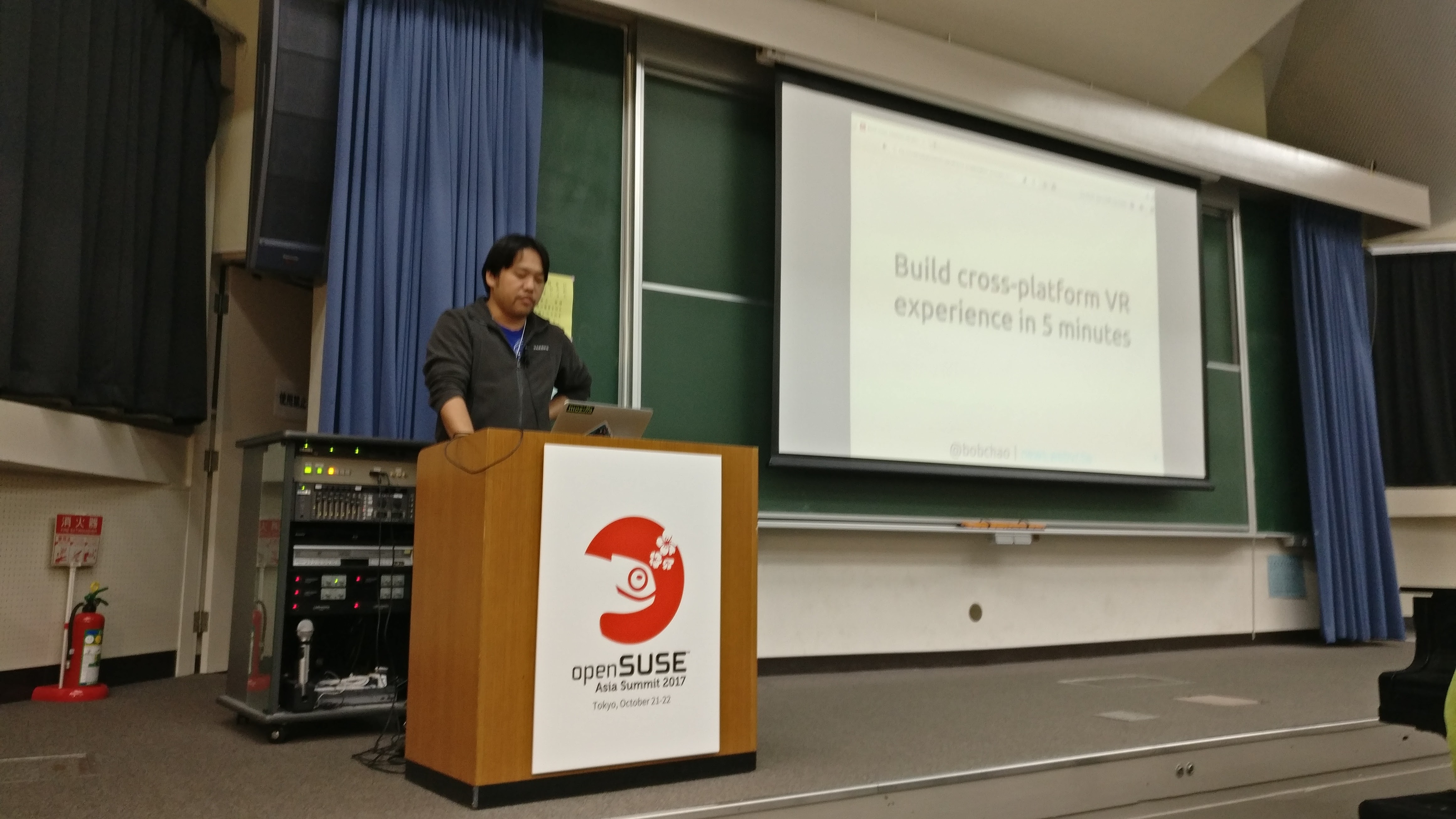
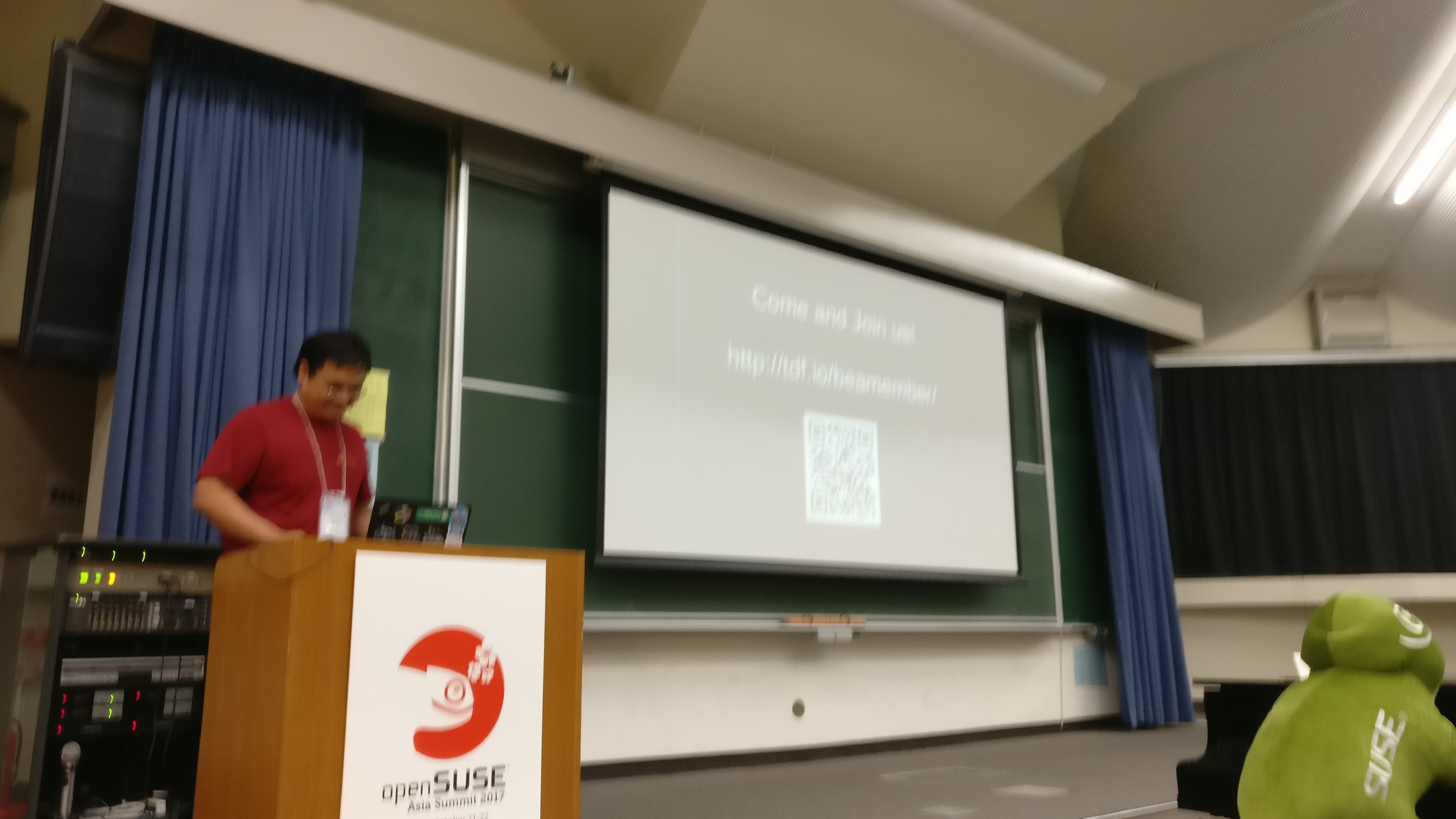
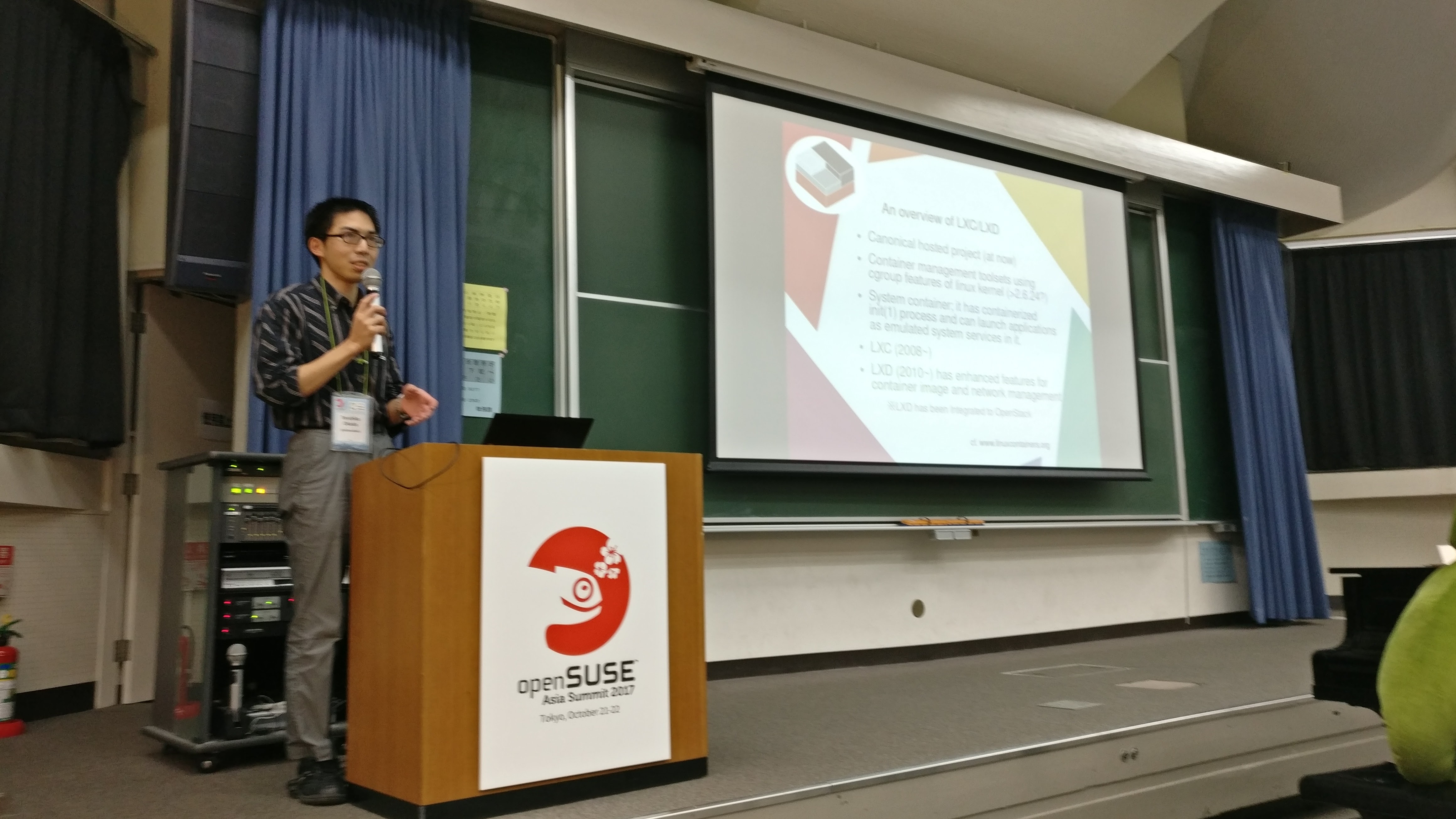
Summit Party
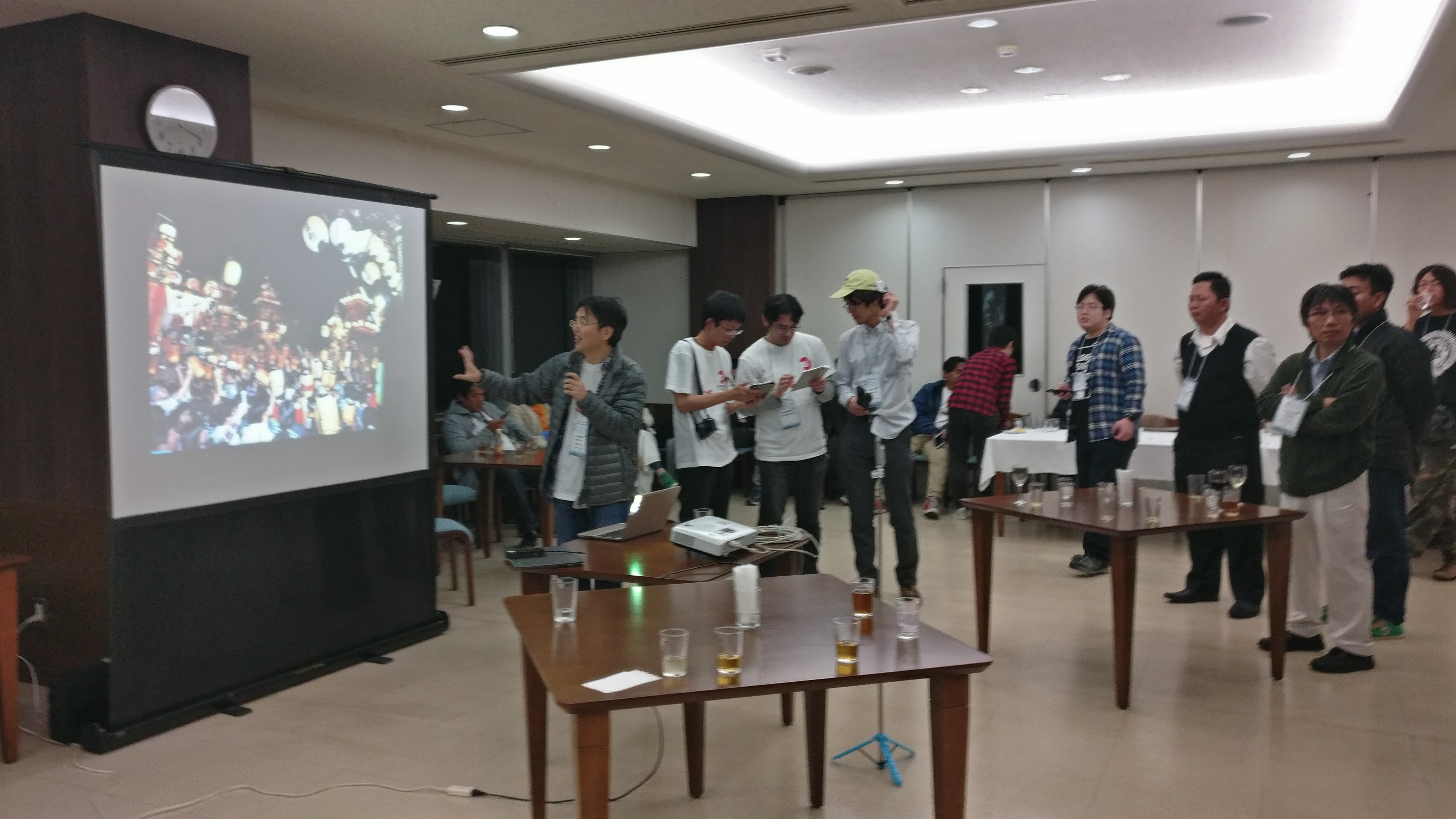
After the first day of the conference, There was a Summit Party at the student restaurant. I drank some alcohol, then move around to say hello to other attendees. I could have a conversation with attendees from Japan, Indonesia, China and Taiwan and more. Some people asked some questions about my speech at the lightning talk. It was very unusual that people also had lightning talk at the summit party while drinking alcohol. Later, I heard from my close friend that it’s very common to have lightning talk with drinking alcohol.
Day 3
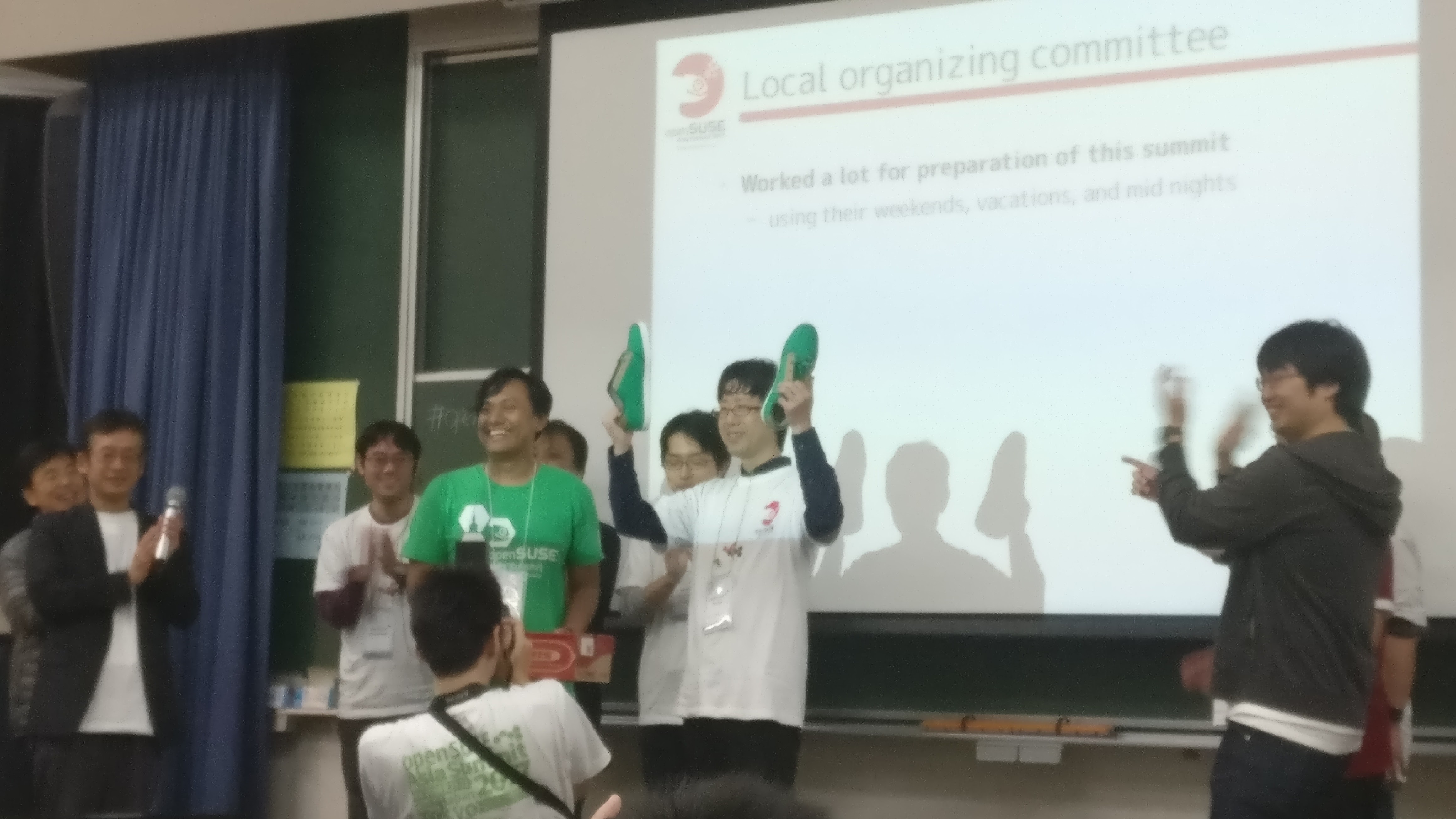
It was my 3rd day of my trip, and 2nd day of the conference. The schedule was started with introducing volunteers, student volunteers, and sponsors of the event. After the introduction, We took a photo of whole attendees and volunteers.
Some memorable presentations
A War of File Format
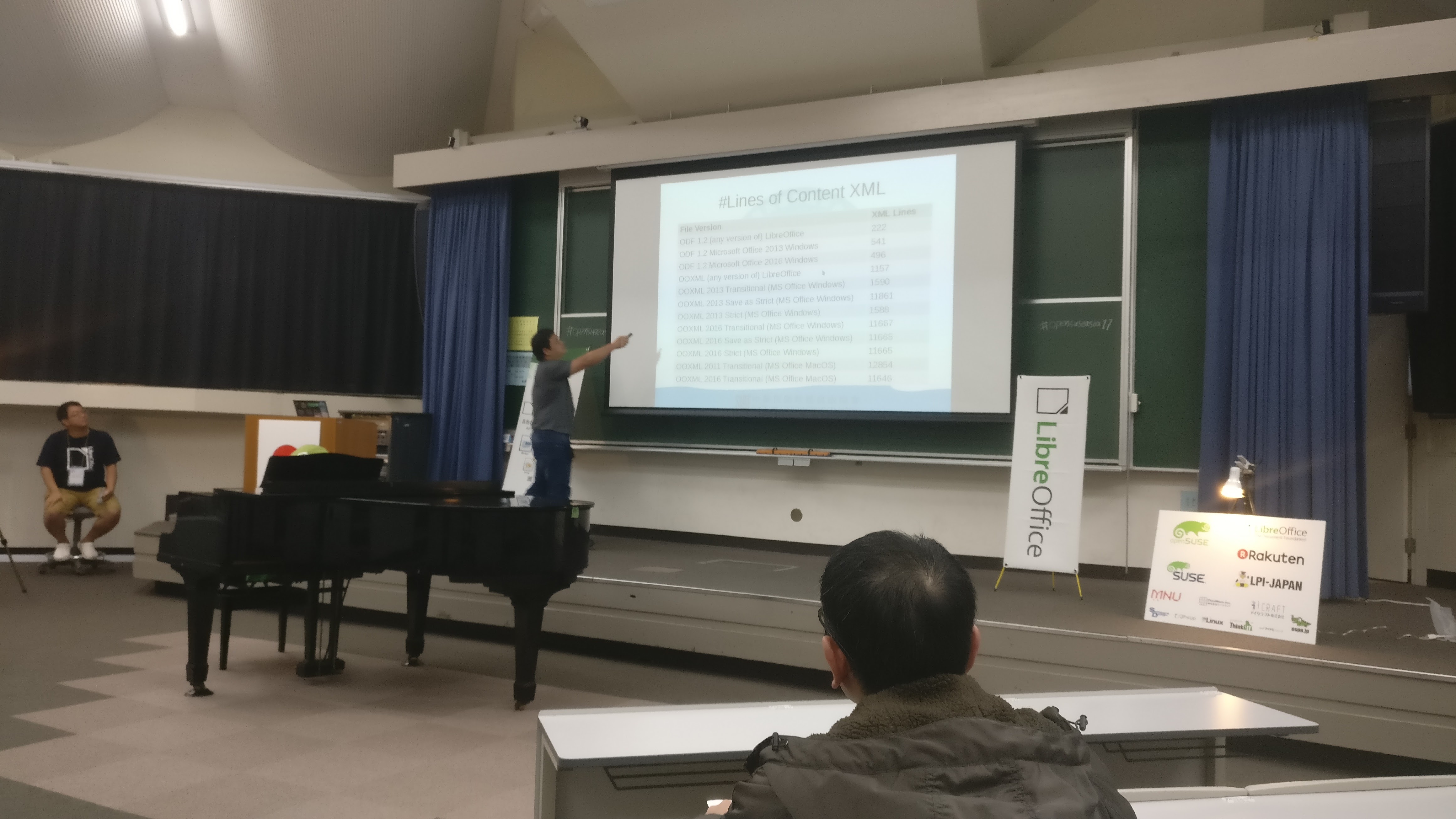
Franklin Weng introduced and compared about ODF(Open Document Format) and OOXML(Open Office XML). that are two international document standards. I learned that ODF is simple and stable and compatible with old version and other office suit. On the other hand, OOXML might be comfortable on Microsoft Office. but it’s not even compatible with old version of Microsoft Office. Because the format is different by the version of them. He also showed that how ODF is simple by just comparing the number of lines when storing same content in ODF and OOXML.
After his presentation, I asked hime about Lock-In case of documents in Taiwan. He answered that Taiwanese government was using OOXML as their standards, but they are changing it to ODF. Also he told me a story about his friend who do 3D modeling art. His friend was using AutoDesk to do his art. But after many AutoDesk version ups, Because support for older version was ended. He couldn’t open his works that was created long ago. So he switched to other software that uses open file format such as Blender, and also encouraged other people to use open format and open source software. From the story and the speech, i could know and understand why using open format and open source software is important.
openSUSE tools on Debian
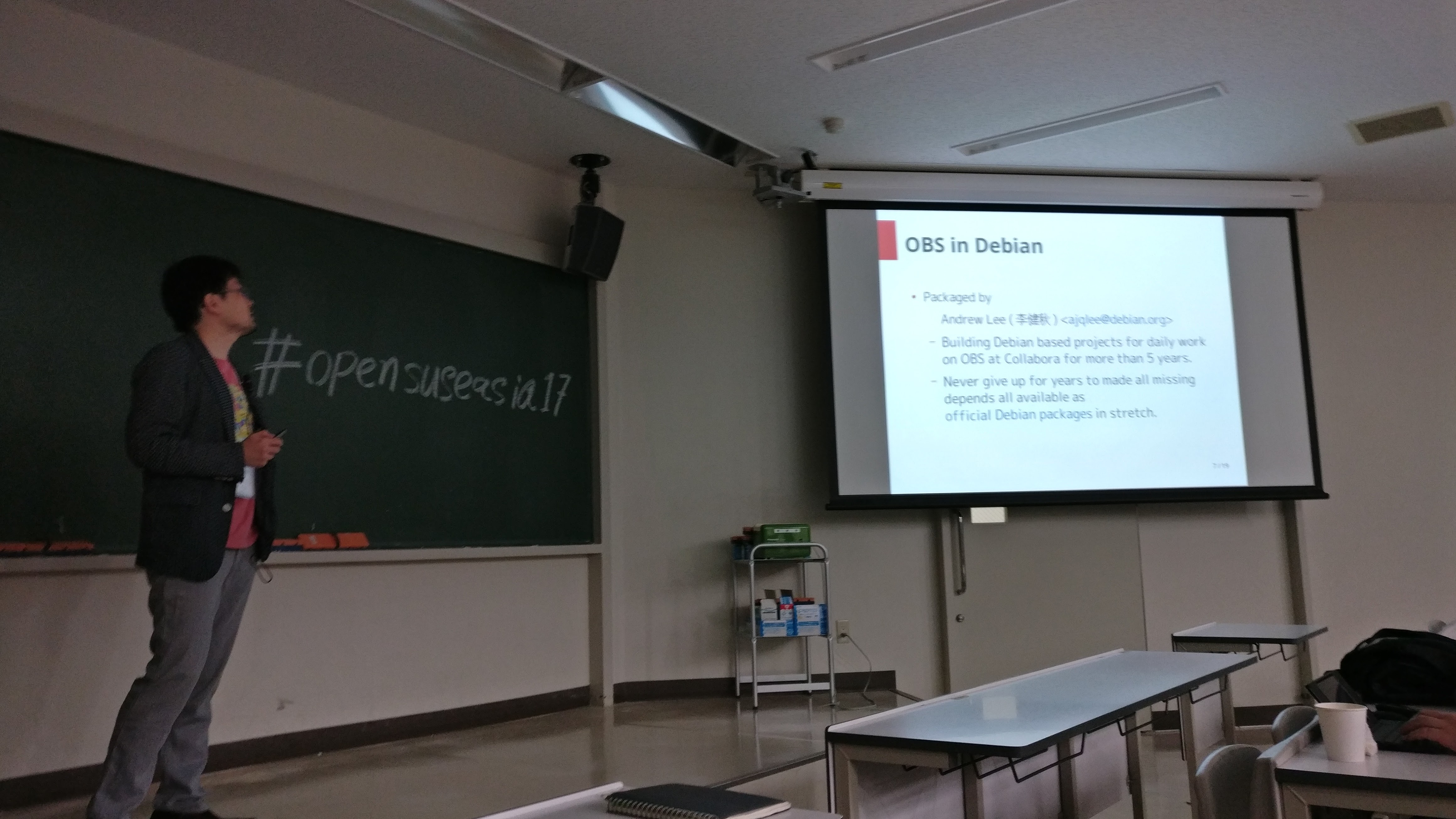
Hideki Yamane from Debian JP and Ubuntu JP talked about what kind of useful openSUSE tools are available on debian. He also introduced when the package for tools began distributed and who is maintaining the package for now. He said that OBS and Snapper are available now in debian, and openQA will be provided soon. Also, he briefly demonstrated how to use tools from openSUSE in debian.
Installing LXQt of openSUSE to USB memory stick in UEFI environment
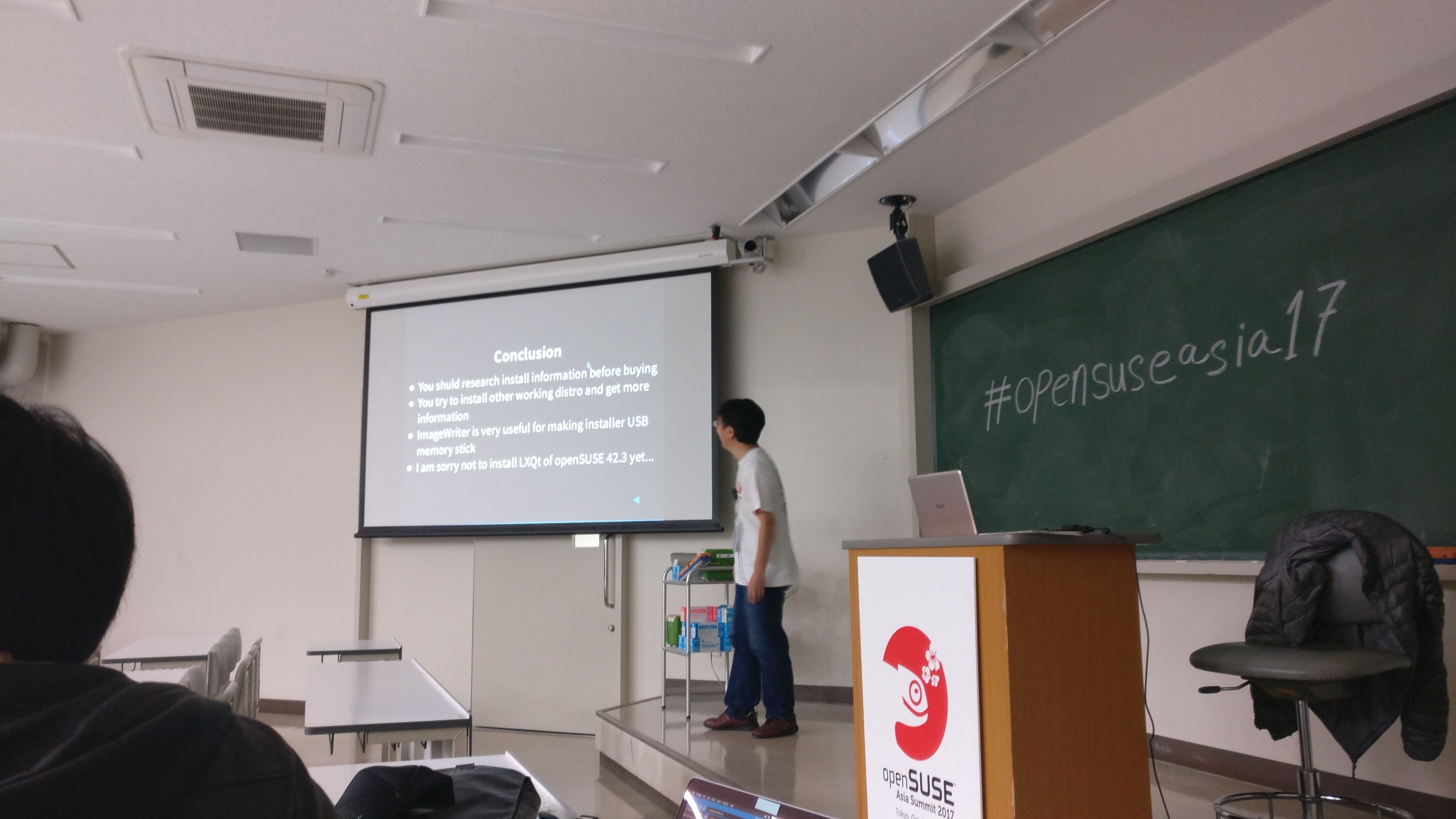
Kentaro Hatori introduced his interesting experience about installing LXQt on his ASUS laptop. He failed to install LXQt on it, But it was a great presentation that expressed his consideration. It’s very common to face with various hardware compatibility problem when installing linux distro on laptop. If you ever experienced this kind of problems, you will sympathize with this presentation. I learned again that when buying laptop for installing linux distro, checking hardware compatibility with the laptop and the distro that i will install is very important.
Lightning Talks
2 proposal for next year’s openSUSE.Asia summit were exceptional. Max Huang who wants to host openSUSE.Asia in Taiwan, presented his proposal in Japanese for the first time of his life. His purpose for hosting was combining GNOME.Asia, COSCUP(The Biggest Open Source Conference in Taiwan) and openSUSE.Asia together. After that, Hillwood Yang presented his proposal for hosting openSUSE.Asia in Chongqing. He briefly introduced the city view and food of Chongqing. Especially, he highlighted female members of Chongqing Linux User Group.
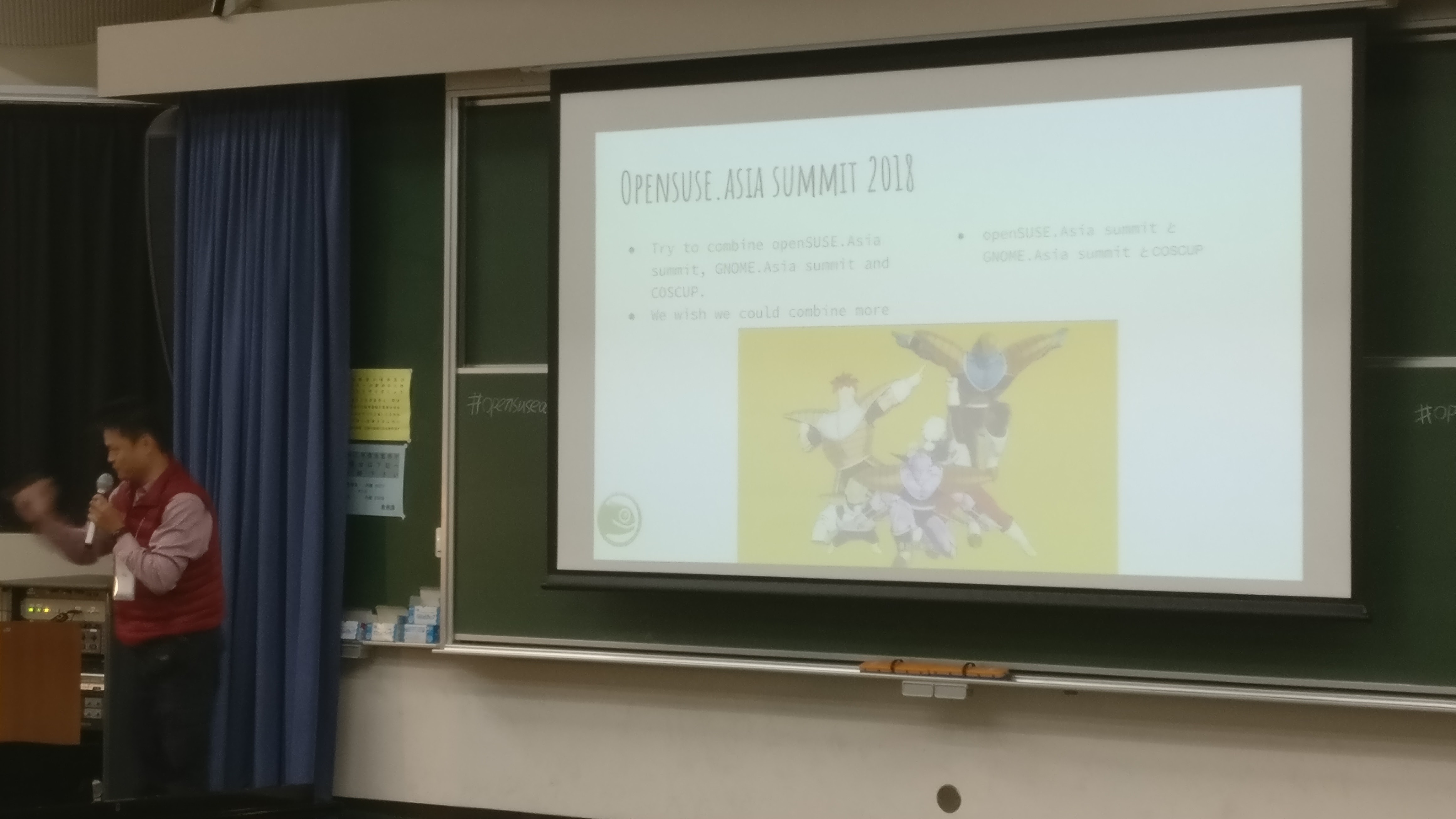
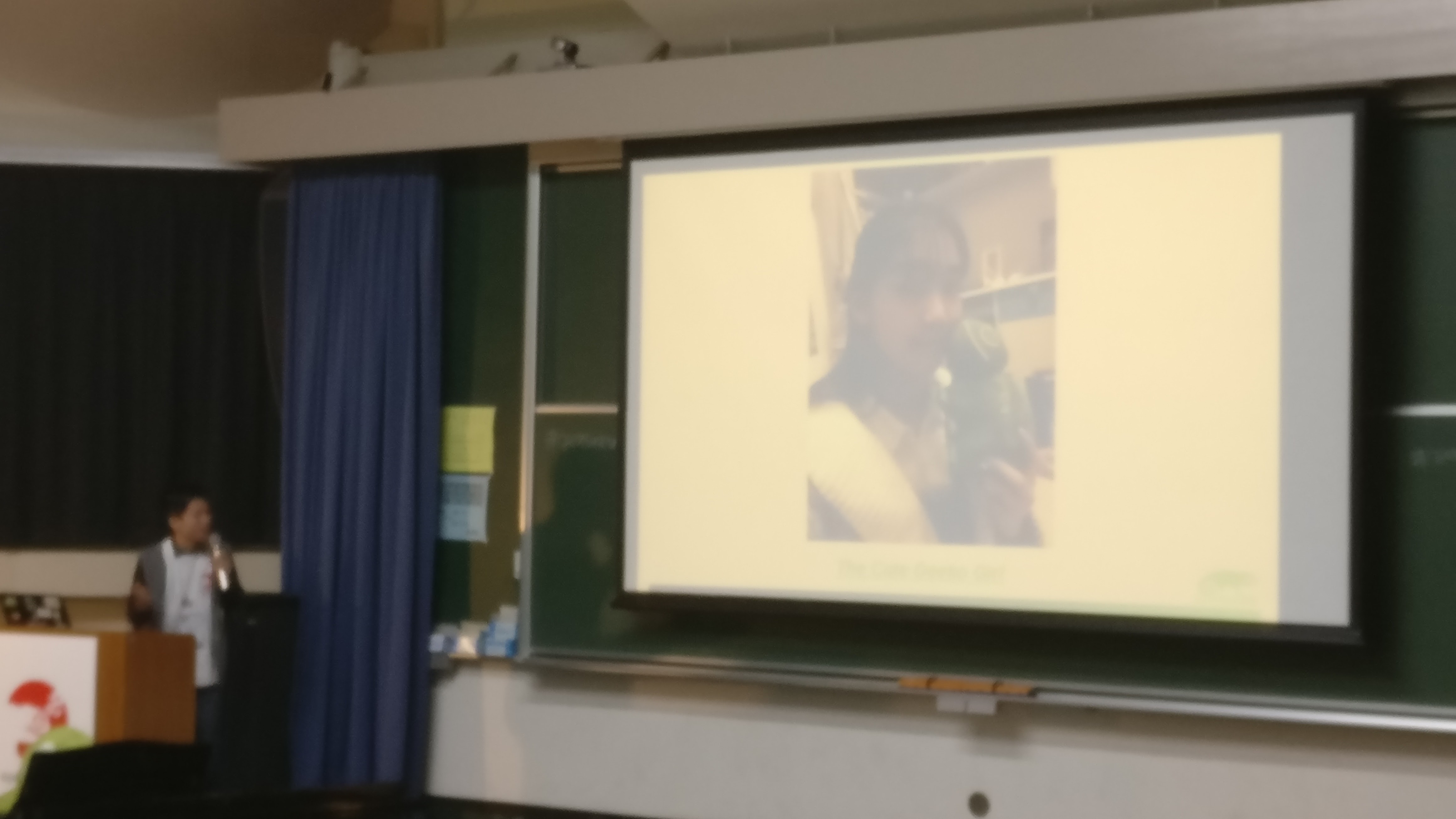
Dinner
For the day of dinner, I joined a small group of Japanese attendees. I had a dinner at the gyudon restaurant near Chofu station with them. and it’s taste was great and the price was acceptable. After the meal, I visited Don Quijote duty free shop near JR East Akihabara station to buy some souvenirs for my family and friends.
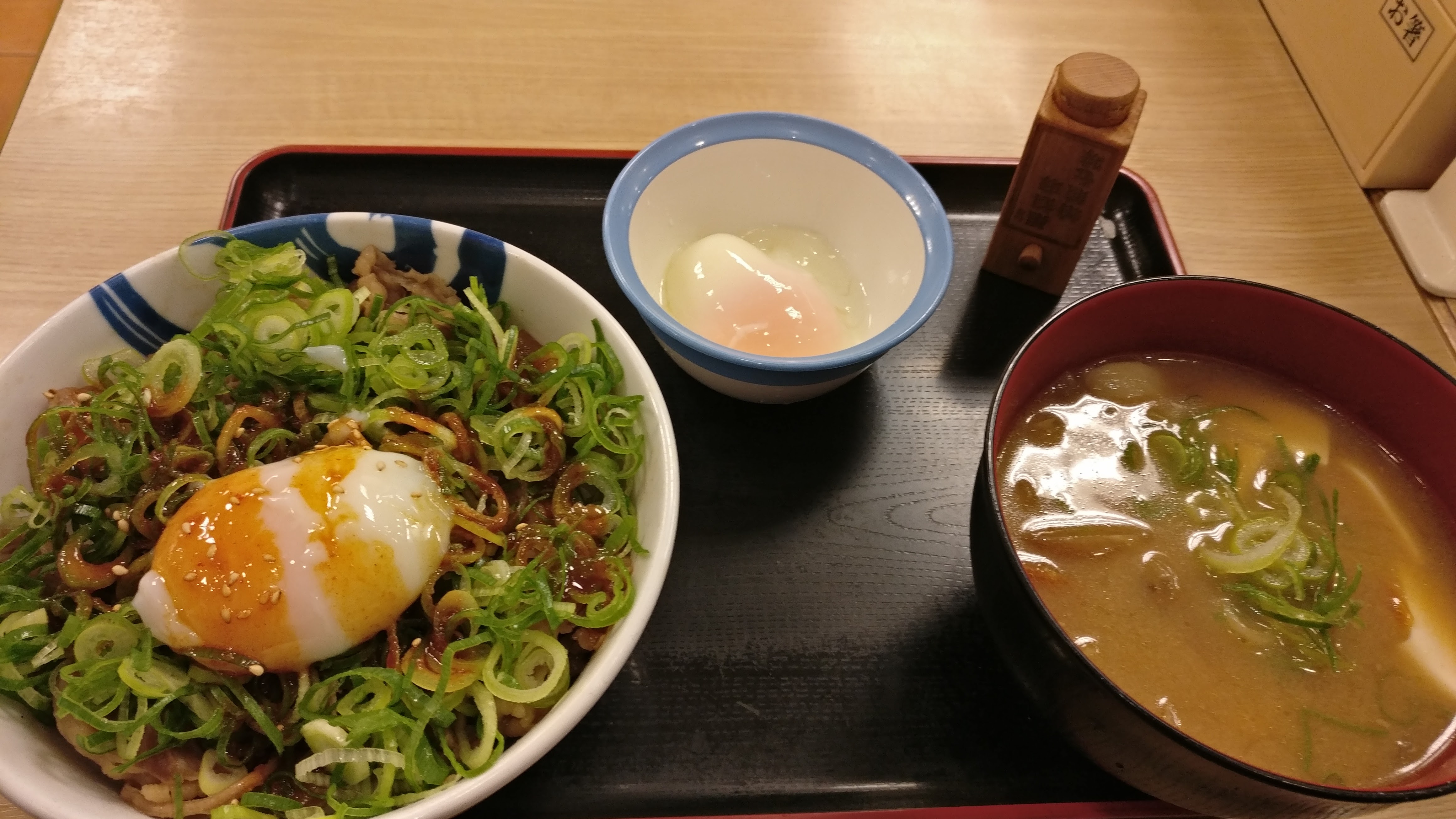
Last Day
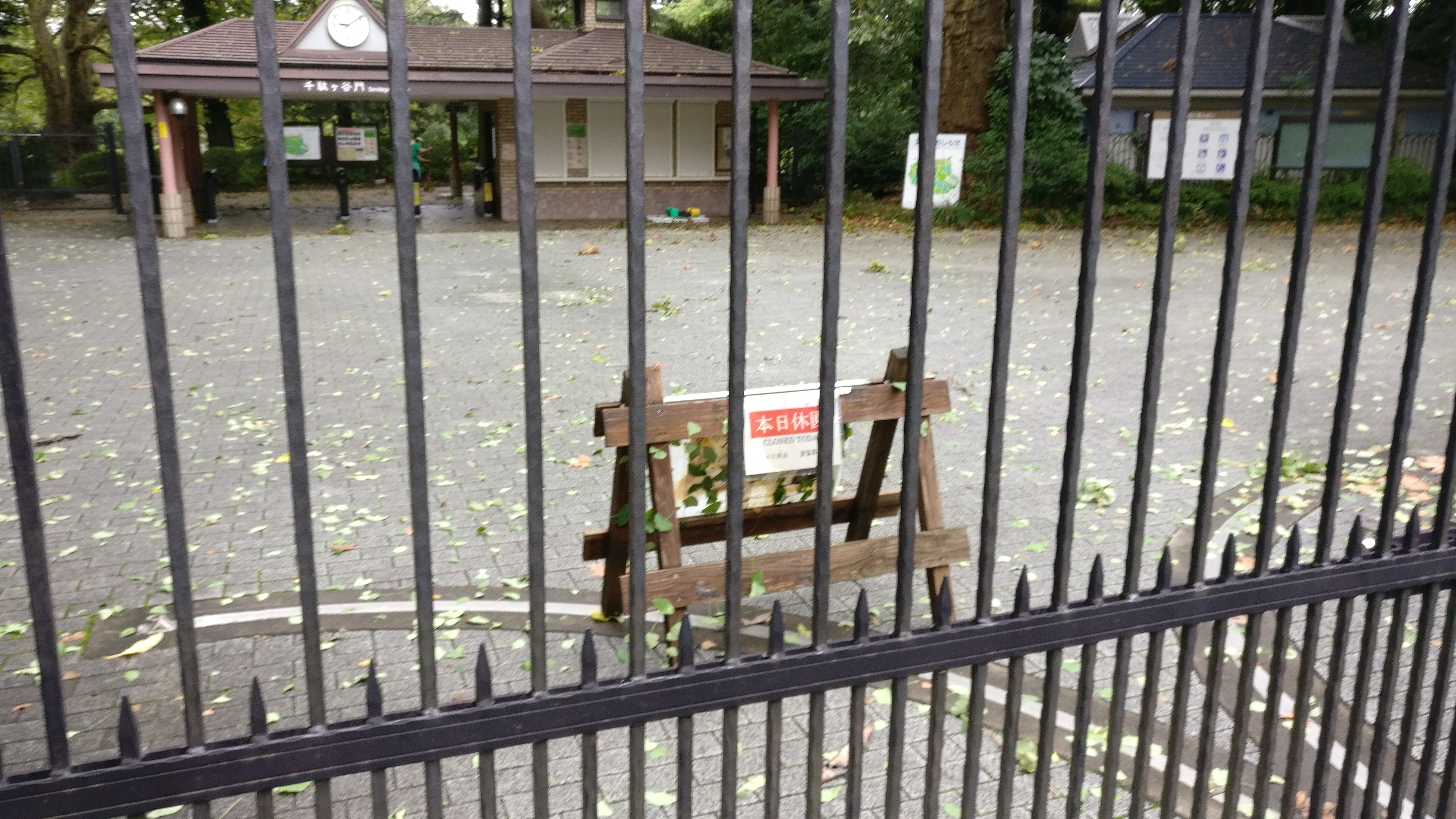
Just like the first day of my trip, I was also busy moving to Narita Airport. I stopped buy Shinjuku station to visit Shinjuku Gyoen, But i couldn’t enter. Because it’s closed every monday.(What? the park has a closed day?) So i had to skip visiting Shinjuku Gyoen.
People i met at openSUSE.Asia Summit 2017 Tokyo
Well, Since i couldn’t remember every person i met. I just organized people by photos i took.
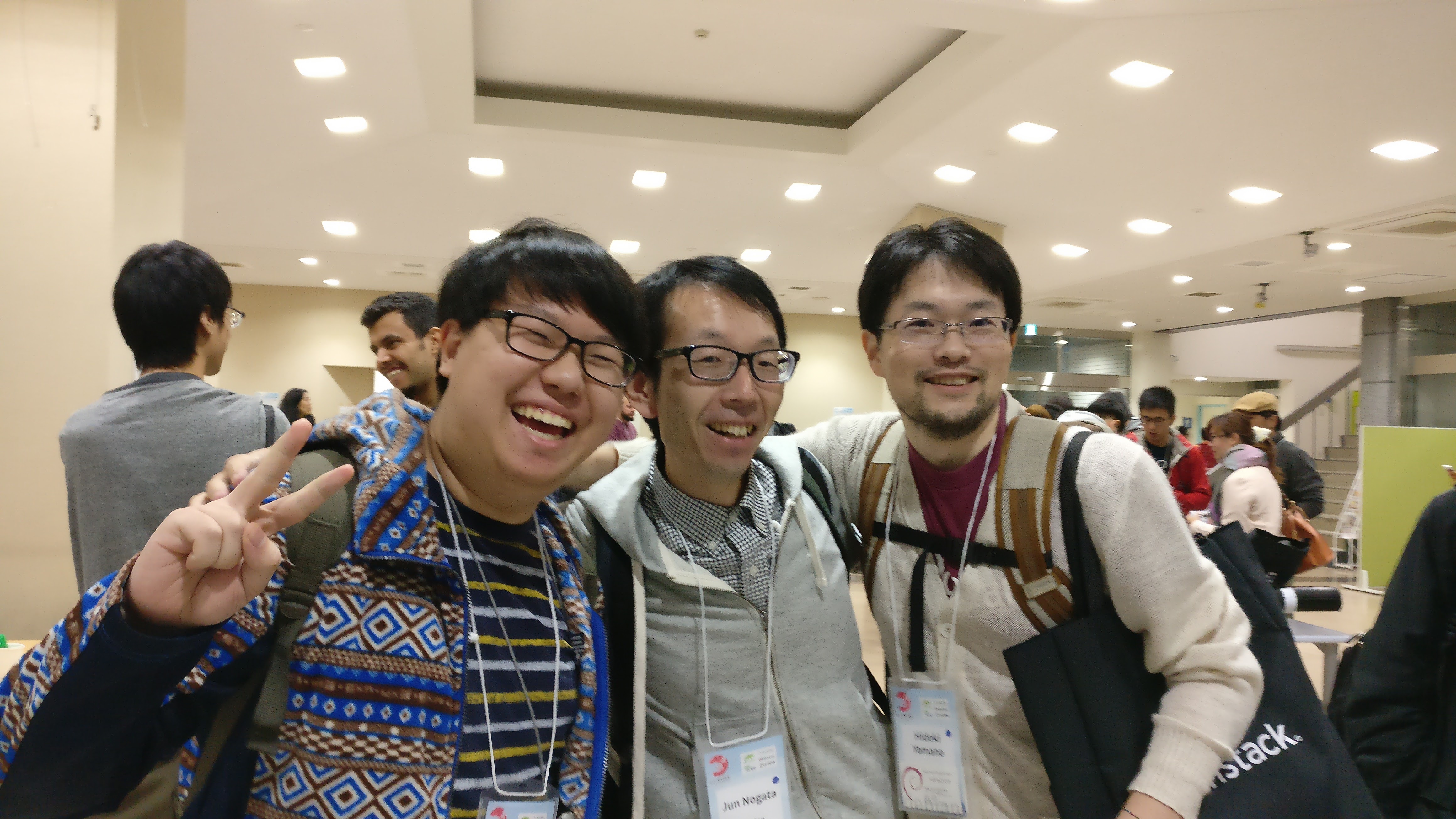
Nogata Jun
I could attend the event because he shared the information about openSUSE.Asia. I first met him at the last KCD(Korea Community Day) event that was held near Gwanghwamun at last February. He gave me and our community(Ubuntu Korea Community) an opportunity for exchange with Japanese open source community.
Hideki Yamane
Hideki Yamane is a member of Debian JP and Ubuntu JP. I first knew him via E-mail contact before attending openSUSE.Asia, then i met him by the introduction from Nogata Jun at openSUSE.Asia.
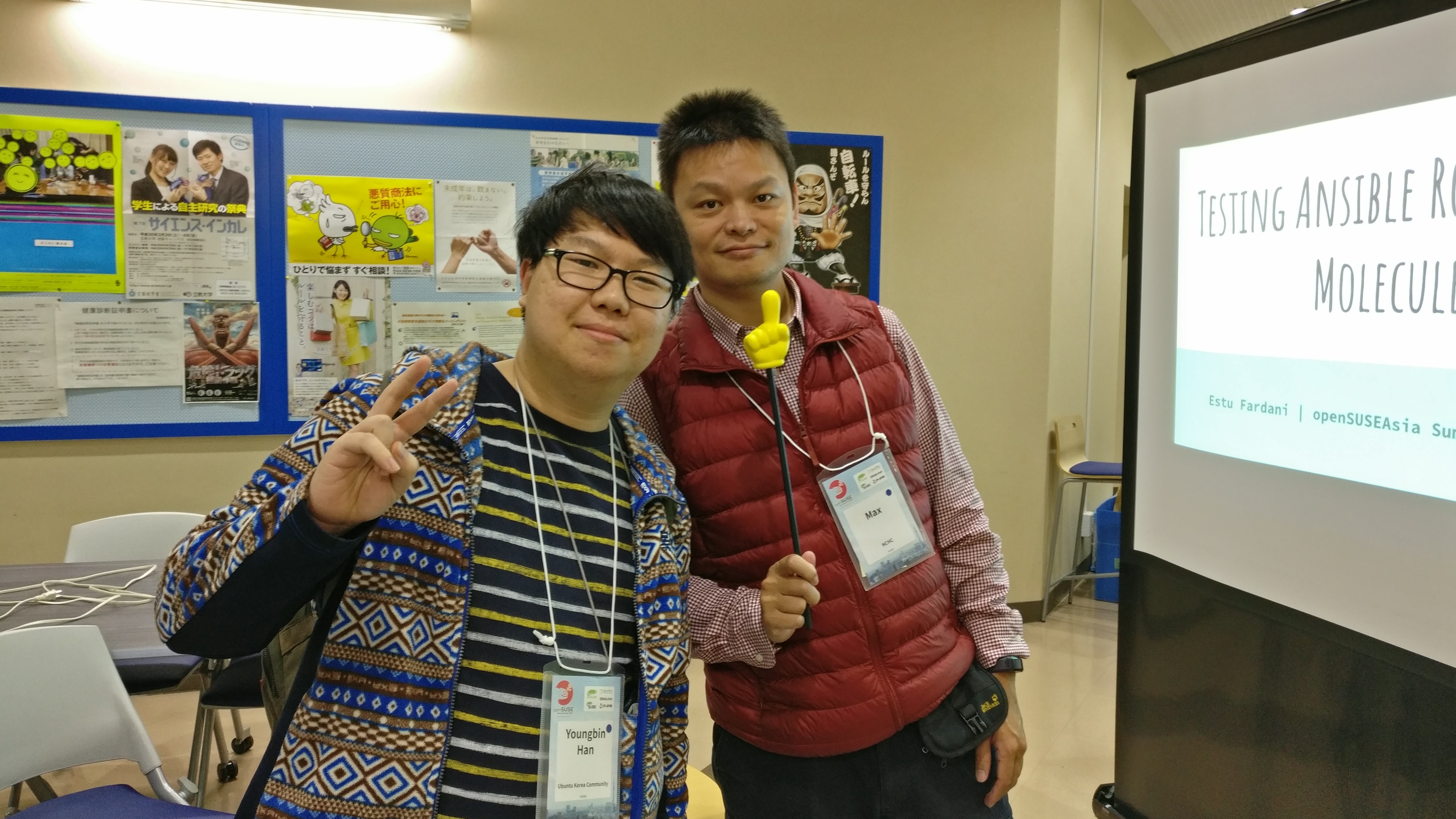
Max Huang(Chunhung Huang)
Max Huang is a council member of openSUSE Taiwan Community. He is good at giving listeners a funny and interesting speech. There’s a person when i see Max is giving a speech, It’s Sangkon Han who is a council member and Content Creator of Ubuntu Korea Community.
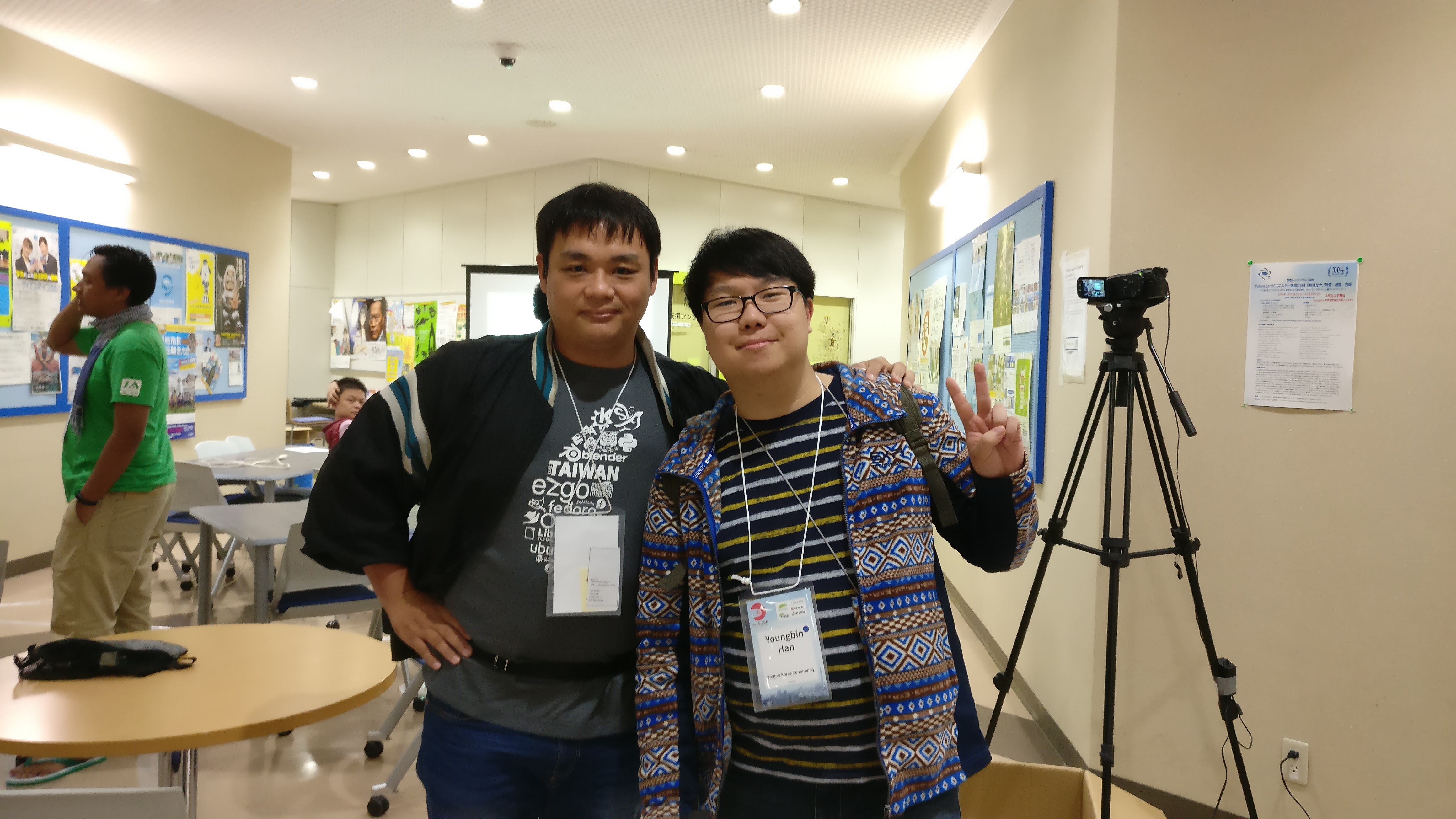
Franklin Weng
Franklin Weng is a member of TDF(The Document Foundation), and very active in Libre Office projects.
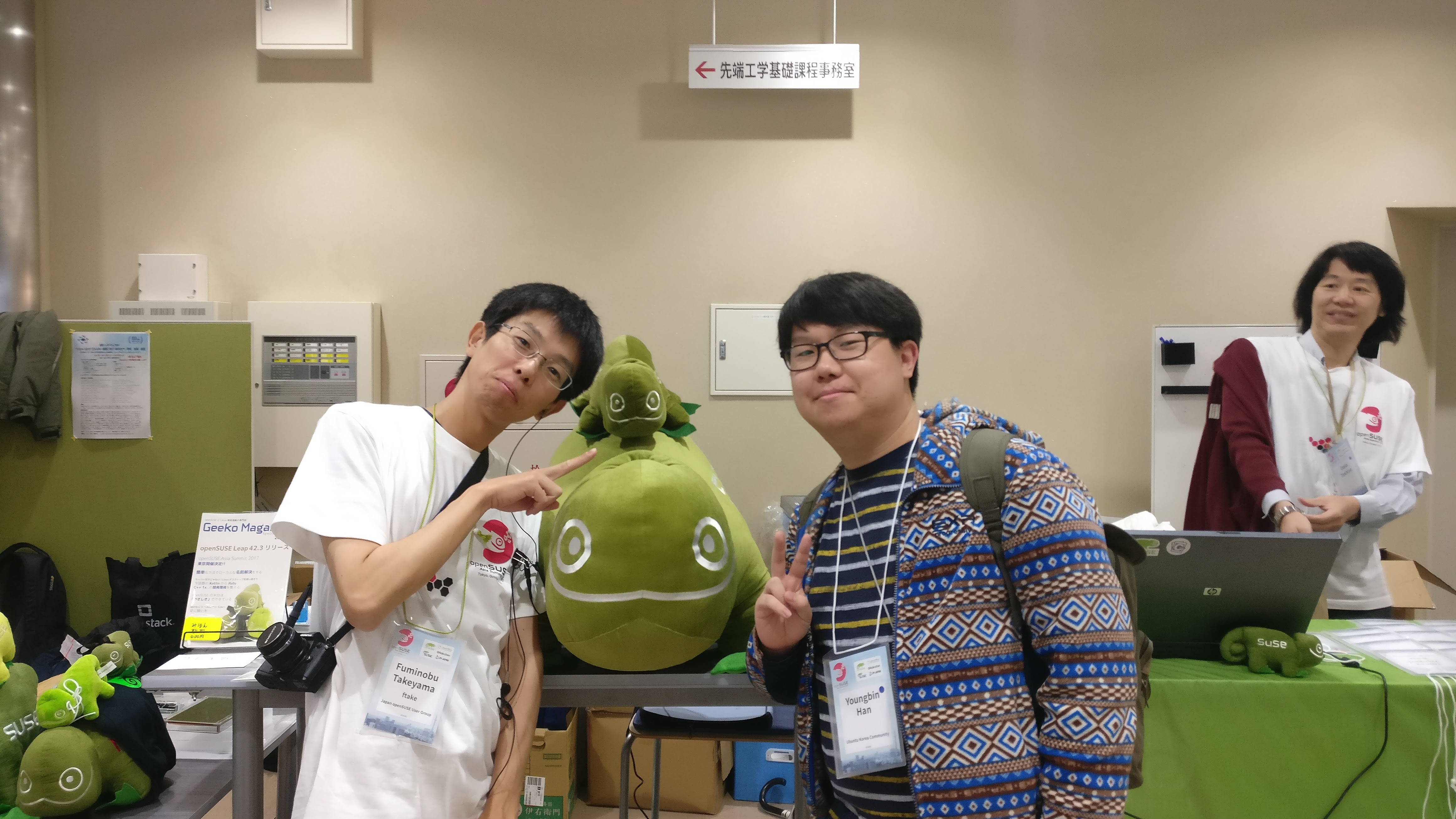
Fuminobu Takeyama
Fuminobu Takeyama is a memeber of openSUSE Japanese User Group. He organized and hosted this year’s openSUSE.Asia Summit as the local committee chair.
How about Open Source Community in Korea?
It was the most frequent questions that other attendees asked me. Many people asked me What kind of Open Source Community is in Korea, What kind of activities they do, and do they have contribution activities. I was a bit surprised that many people asked this kind of questions. Because i thought open source activities is very active in Korea. But they really don’t know about open source activities in our country. Maybe, It’s because open source activities and communites for programming languages, tools and framework related to development are very active and various. But for things like Linux Desktop such Ubuntu, Debian, openSUSE, Libre Office, KDE, Gimp isn’t very active. Franklin Weng said that he tried to organize an event related to KDE with Community in Korea, but he couldn’t because he couldn’t find community in Korea. Fuminobu Takeyama also wanted to do thins with openSUSE Community in Korea. But he couldn’t do that for the similar reason.
Since i don’t know every details about Open Source Communities in Korea, and what i know well was about Ubuntu Korea Community that i’m operating now. I could just roughly explain about communities, and common activities of them in Korea.
Activities of Communities in other countries
Since most of conferences and community activities are only available in Seoul, the capital city of Korea. If people live in other region want to participate, they usually just visit Seoul to attend. But in other countries like Japan, Taiwan, China and Indonesia. many activities are also very active in many different region. For China, people attended from various cities like Beijing and Chongqing. For Taiwan, It’s possible to find many activities around Taipei and Kaohsiung. People from Indonesia also attended from many different cities. It would be great if activities in Korea also spread from Seoul into other regions.
Conclusion
It was the first conferences that i attended overseas. And it was great. Volunteers of the event was very kind, and I didn’t say hello to many attendees when i’m attending conferences in Korea. But this time, I talked with various attendees from various regions. Because of that, i could make some friends at the event. Finally, Thanks to Nogata Jun who shared information about this event. and Fuminobu Takeyama and Volunteers for welcoming me who hosted this event. :)
Read this post in other languages
- [한국어(Korean) - Original]({{ site.baseurl }}{% post_url 2017-10-23-opensuse-asia-2017-tokyo %})
